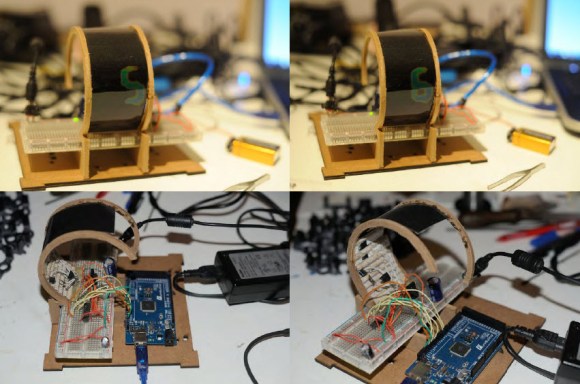
[Marin Davide] was on a mission. A mission to build his own curved display screen, using an Arduino, nichrome wire, and thermochromic liquid crystal ink.
The prototype he’s designed uses a sheet of plastic coated in thermochromic ink, curved on an MDF frame. This particular thermochromic ink turns bright blue when heated to around 27°C.
To display digits, he’s created tiny segments of the 7-segment display by wrapping the nichrome wire around pieces of cardboard, which then have been glued to the back of the display. Each of these is controlled separately from his Arduino Mega. He muses that you could also make a rudimentary dot matrix display with this — it would be interesting to see what kind of resolution you could obtain!
To see more photos check out the original DesignNews post linked above. We’re not sure why the bulk of the details are only available in this PDF. If we’re just missing a direct link to the original project page let us know in the comments and we’ll update the post.
Interested in more thermochromic black magic? How about these awesome temperature sensitive photos? Or what about a digital clock face, illuminated by heating resistors?















What about instead of just a 7 segment display, actually shaping each individual number out nixie-tube style?
I imagine the difficulty would be in keeping all the shapes flush against the panel without shorts or obvious “jumper gaps” at the digit intersections
The “jumper gaps” would probably be OK, since the heat would spread around a bit, enough to cover the gaps if they’re fairly thin.
I imagine that could be easier to accomplish using conductive ink segments.
To the dot matrix; I wonder if a multiplexed X/Y matrix would work easily…
For ultimate thinness, etching very narrow and zig-zagged lines on a flexpcb might work to replace the nichrome. Too bad this requires quite a lot of power, many applications where this would be useful don’t have that available.
One could of course also solder small resistors on a flexpcb for the heating, but at that point might as well use tiny SMD LEDs.
Why curved?
The TV industry is hyping curved screens now, why. After decades of looking at curved screens (boob tubes) we finally got them flat and undistorted just like a canvass. Is every artist to paint in bowls now.
Do they still have those testers on battery cells that are thermic, they are ready to hack. I took one apart once but I didn’t measure it’s resistance.
Another item, those thermal printers of yore. The print head might be worth a hack.
The big thing isn’t making a permanently curved screen really.
One part is making a screen that can bend quite a bit without breaking so you don’t break that mobile or laptop display when you drop it.
Another more distant idea is roll up TVs, you could have a large screen TV delivered in a roll instead of taking up a whole truck by itself.
I was thinking this is one more step to a digital snap bracelet.
The new curved screens are curved in the opposite direction from the old tube tvs. They actually help prevent distortion of the image.
Living rooms aren’t getting any bigger, and as TVs grow in size, it becomes less and less comfortable to view them. Curving a screen’s edges towards the user helps keep everything ergonomic. It’s the same reason why, if you rock three or more monitors, you probably have them set up in a crescent shape: so you can actually see them.
This project here, however, is a different beast entirely, and the article mislabeled it. Your comparison to curved TVs is thus a non-sequitur. This is a project to make a DIY flexible display — useful for bracelets, print ads, architecture.
Infrared laser diode + galvo scanner, anyone?
Fantastic trick!
The battery sensors can be used, this is actually doable.
I collected a few but lost interest due to issues with connecting them, however Z axis tape is an alternative.
Re. displays, one idea I had is to make interactive pictures with an IR sensor, EL paint and some sort of flexible interconnect.
Apparently this is doable, the trick is to use UV setting glue as a gap filler and touch screen film as the front and back contacts as this is both transparent and flexible if the correct proportions are used; needs to be done in a vacuum or the paint lasts about a week due to bubbles forming.
That is so cool! Can you apply the heat differently and make a colored display?
Probably but you would need very stable temp control and a way to prevent temp leakage.
I really like this concept. Personally, I’d have used a grid of small thermoelectric elements, budget permitting.
The benefit to this approach would be cold pixels at the periphery of every hot pixel, so the image stays sharp and clean. Not to mention, Yamaha makes some pretty damn tiny thermoelectric elements, for example.
Won’t body temp. just interfere
Nice idea! Since the color size and shape change based on the amount of heat, it would be fun to see the different methods of shading and tightening the line accuracy.